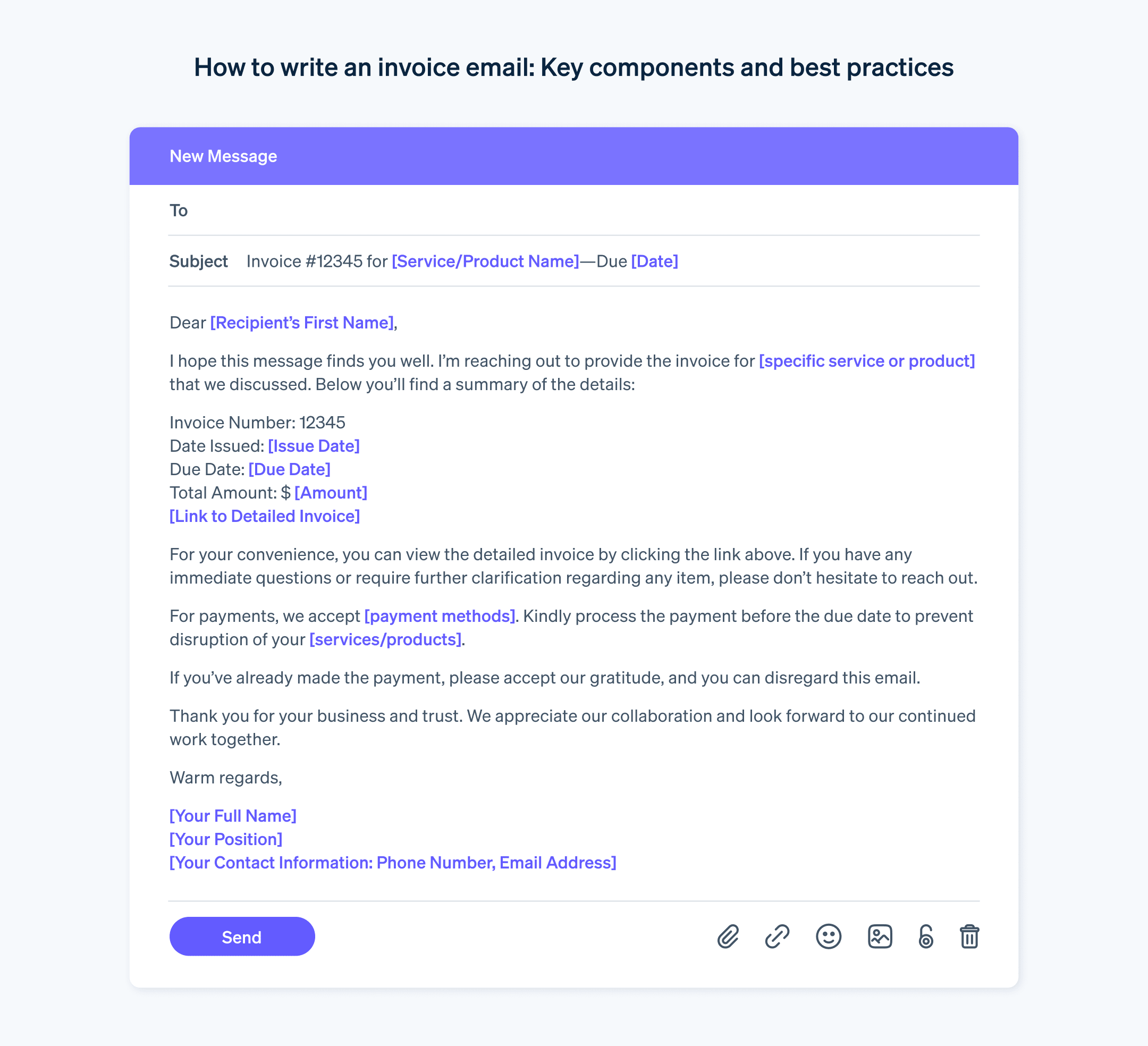准确及时的开票可以提高管理效率,并通过减少支付延迟维持稳定的现金流。然而,不清晰的发票电子邮件可能导致支付延迟或争议,损害企业与客户的关系。
开具发票不仅关系到按时收到付款,还关系到维护公司声誉以及保持企业和客户积极、互惠的体验。一封精心撰写的发票电子邮件应包含所有必要细节,如发票日期、支付说明、接受的支付方式以及提供的服务明细清单。
以下是如何撰写有效发票电子邮件的快速指南,可确保及时付款并维持客户信任。
目录
- 什么是发票电子邮件?
- 发票电子邮件的主要组成部分
- 如何开具发票
- 如何撰写发票电子邮件
- 发票电子邮件模板
- Stripe Invoicing 如何提供帮助
什么是发票电子邮件?
发票电子邮件是公司发送的正式通信文件,用于请求为已提供商品或服务支付款项。企业不是通过邮件发送纸质发票,而是以电子方式发送发票电子邮件。
结构良好的发票电子邮件可确保及时支付并提供所有必要的支付细节以避免混淆。
发票电子邮件的主要组成部分
一封有效的发票 电子邮件包含多种元素,使沟通透明、可信、可操作。以下是主要组成部分:
- 清晰的主题行:撰写直白、描述性的主题行,让收件人立即了解电子邮件的意图。例如,“来自 ABC 类公司的发票 #12345”或“3 月服务的付款请求”。
- 发件人身份:使用可识别的地址(最好是包含企业名称或网站域名的地址)发送邮件,以降低邮件被标记为垃圾邮件或被收件人忽略的风险。
- 个性化问候:在问候语中使用收件人的姓名或企业名称,以建立联系,并表明该电子邮件不是普通或自动发送的信息。
- 发票明细:突出显示详情,如发票日期、发票编号、应付总额和支付截止日期,使收件人能快速了解其义务。
- 详细分项说明:逐项列出您提供的服务或产品及其单项成本,以提高透明度。这部分内容可以放在电子邮件正文中,也可以放在附件中。
- 支付说明和方式:列出可接受的付款方式,无论是信用卡、银行转账、支票还是其他选项。
- 链接或附件:明确指出您是否以嵌入式链接或附件的形式提供发票,并添加如何访问发票的直接说明。
- 联系信息:为任何与账单相关的问题提供联系信息,以便收件人能够轻松解决问题、解决错误或寻求澄清。
- 条款和条件:明确说明任何相关条款,例如滞纳金或提前付款折扣,以充分告知收件人其作为或不作为的影响。
- 明确的行动号召:添加直接提示,例如“请在 [到期日]之前处理此付款”或“点击此处立即付款”,以引导收件人进行下一步。
每一个组成部分都有助于提高发票电子邮件的效率。当它们结合在一起时,就能打造全面、易懂和可操作的账单沟通。
如何开具发票
创建发票时要精确且专业。下面概述了开具发票的步骤和最佳实践:
- 准备发票:收集任何必要的数据,如提供的服务、支付条款和发票日期。如果您定期开具发票,可考虑使用会计或发票软件(如 Stripe Invoicing)来自动化并高效管理开票流程。
- 审核发票:每张发票都应准确无误。再次检查所有细节,尤其是收件人信息、费用以及支付说明和截止日期。错误会引起纠纷和不必要的延误。
- 发送发票:无论是发送电子邮件、邮寄纸质发票,还是使用发票平台提供的数字交付服务,都要选择一种能反映您业务的交付方式。无论您选择哪种方法,请确保将发票发送给正确的人员或部门,并在正确的时间发送。
- 主动跟进:有时客户会忽略发票。最好在到期日之前发送系统提醒,以保证按时付款。如果逾期付款,继续定期跟进。
- 记录付款收据:收到付款后,立即在会计系统中记录。这有助于税务合规,并为未来的财务规划提供有价值的数据。
- 解决逾期付款:如果发票仍未支付,请决定下一步措施。可选择包括收取滞纳金或暂时停止服务。始终参考发票中规定的条款,并遵守与客户达成的任何协议。
如何撰写发票电子邮件
发票电子邮件可以为交易定下基调。有效的发票电子邮件应吸引客户的注意力,提供清晰的信息,并及时采取行动。以下是精心撰写发票电子邮件的方法:
- 确保主题行清晰明了:您的主题行应清楚描述电子邮件内容。请考虑使用“[您的公司名称]的发票 #12345”或“[月份/服务]的账单详情”等格式。
- 熟悉地问候语:从个性化的问候语开始。使用收件人的名字,建立联系并表明电子邮件的目标受众。
- 开门见山:问候之后,立即提及邮件的目的。例如,“附件是为[月/服务]提供的服务的发票。”
- 包括重要细节:简要概述最重要的发票详细信息。这可能包括总金额、付款到期日以及服务或产品的简要说明。
- 附上发票:始终以 PDF 格式附上发票或提供安全链接以供在线查看。这样可以确保在不同平台和设备上的可读性。
- 概述支付方式:详细说明收件人如何完成付款。无论是银行转账、信用卡付款还是其他方式,都要提供明确的说明。
- 表达谢意:即使是在日常业务交易中,一句简单的“谢谢您”也能维持积极的关系。
- 提供帮助:在结束语中表明您愿意提供帮助。例如,“如果您有任何问题或需要更多细节,请随时联系我们”。
- 加入签名:最后附上你的专业签名。签名应该包括您的姓名、职位和公司联系方式。
- 校对:在发送电子邮件之前,请校对邮件的清晰度和准确性。它将反映您的专业精神和对细节的关注。
这种方法将创建一封精心撰写的发票电子邮件,在大多数情况下都有效。每个企业应根据其独特需求优化其开票流程。
对于处理多个客户、提供灵活支付方式或签订长期合同的企业,定制发票模板以反映特定的支付说明、逾期支付费用和接受的支付方式非常重要。
此外,如果您的企业经常遇到逾期支付的情况,设置自动支付提醒并概述明确的支付条款可以鼓励及时支付。
发票电子邮件模板
以下发票电子邮件模板仅为示例。它未包含针对品牌风格、您运营的企业类型、提供的产品或服务或与客户关系性质的定制内容。请根据您的业务和需求对以下模板进行个性化定制。例如,您可包含在线交易的支付链接、提供银行转账的银行账户详情,或指示收件人登录客户门户查看并处理发票支付。
下面是发票电子邮件的基本模板:

Stripe Invoicing 如何提供帮助
Stripe Invoicing 提供一整套工具,帮助您更高效地创建、发送发票并收款。借助 Stripe Invoicing,您可以:
- 更快收款:通过 Stripe 针对转化率进行优化的结账体验,允许客户即时在线支付发票。
- 自动化账单流程:轻松创建、定制和发送一次性或经常性发票 - 无需编写代码。Stripe Invoicing 自动跟踪支付、发送提醒并处理退款。
- 按需配置:可对 Stripe Invoicing 进行配置以满足当地的某些发票格式要求。
- 与您的工具集成:Stripe Invoicing 无缝连接您现有的第三方会计和业务管理软件。
- 简化运营:通过自动将发票数据同步到会计系统,减少手动数据输入和管理开销。
请参阅 Stripe Invoicing 文件,了解关于 Stripe 如何帮助简化开票流程并加快收款的更多信息。
本文中的内容仅供一般信息和教育目的,不应被解释为法律或税务建议。Stripe 不保证或担保文章中信息的准确性、完整性、充分性或时效性。您应该寻求在您的司法管辖区获得执业许可的合格律师或会计师的建议,以就您的特定情况提供建议。